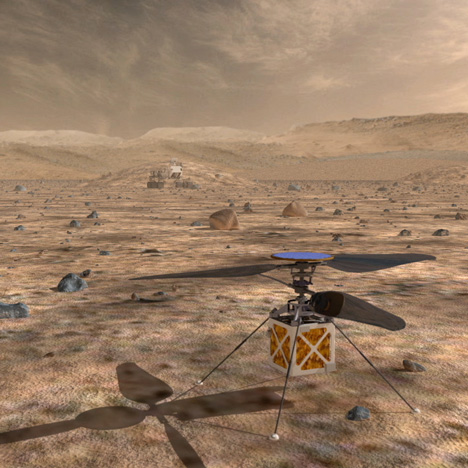NASA plans to use drones for exploring Mars
News: NASA is testing an unmanned aerial vehicle that would scope out the terrain of the red planet to decide the best routes for rover vehicles to explore (+ movie).
Engineers at NASA's Jet Propulsion Laboratory (JPL) at the California Institute of Technology are developing an autonomous helicopter that would be able to provide views of Mars that the current land-bound Mars Rover vehicle is unable to capture.
The solar-powered Mars Helicopter would scout ahead of a future rover on daily two- to three-minute flights, covering approximately 1.5 kilometres in distance each time.
Images of the landscape taken from above would be used to inform the rover drivers on the easiest routes to take or most-interesting sites to explore next.
"If our rover was equipped with its very own helicopter that could see over tall objects in front of it, it would allow us to make decisions much more efficiently on which way to command the rover," said Mike Meacham, mechanical engineer at JPL.
The photographic data could also be used by scientists to gain further knowledge about Earth's neighbouring planet.

To fly in Mars' thin atmosphere, the drone's blades must spin at 2400 rotations per minute (RPM) to gain enough lift. The vehicle must also be capable of multiple take-off and landing manoeuvres on the rocky terrain.
"Over the course of the last year we have done a number of tests in our 25-foot vacuum chamber using scale models where we pump down to Mars densities, demonstrating lift of these kinds of blades," said Bob Balaram, chief engineer of mobility and robotics systems at JPL.
"There's the challenge of keeping the whole mass of the system small so that we don't overwhelm the lift capability of this system."
Currently around the size of a tissue box, the one-kilogram proof-of-concept design measures 1.1 metres across from the tip of one blade to the other. Four thin flexible legs absorb the impact when the helicopter touches down.
"Because this thing is going to take off every day and land every day, we want to make sure we have a bulletproof landing system, and landing is the riskiest part of any mission," said Balaram.
If the project is a success, it could open up opportunities for exploring other heavenly bodies in the Solar System.
"This would be the first flight of a controlled aerial vehicle in another planet's atmosphere," Balaram said. "This could pave the way for similar flying crafts on other planetary bodies such as Titan and Venus."
NASA is also hoping to explore Venus with inflatable air-born "habitats" and recently created a series of posters advertising holidays on planets that could potentially support life.
Image courtesy of NASA/JPL-Caltech.